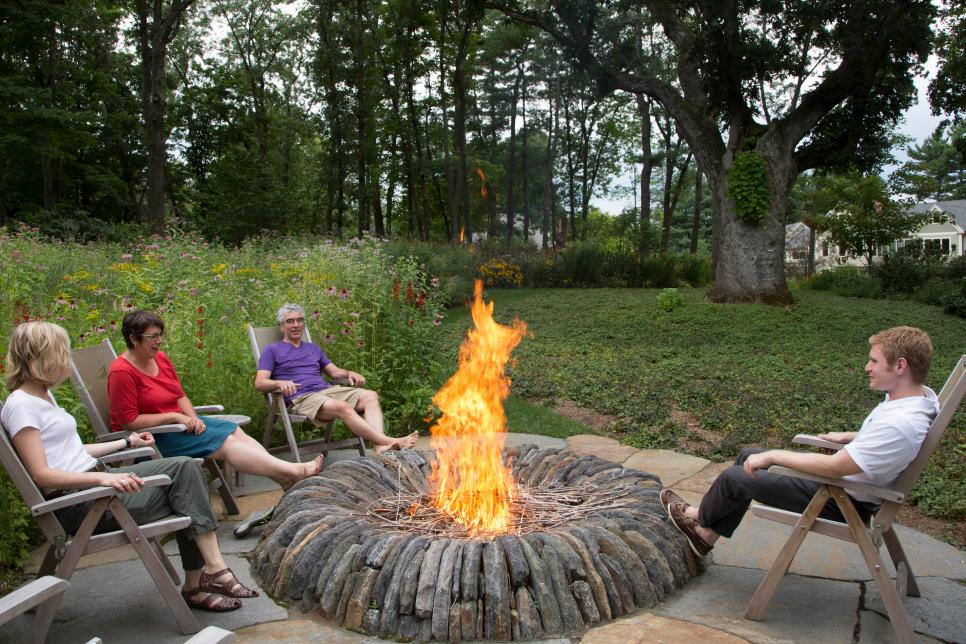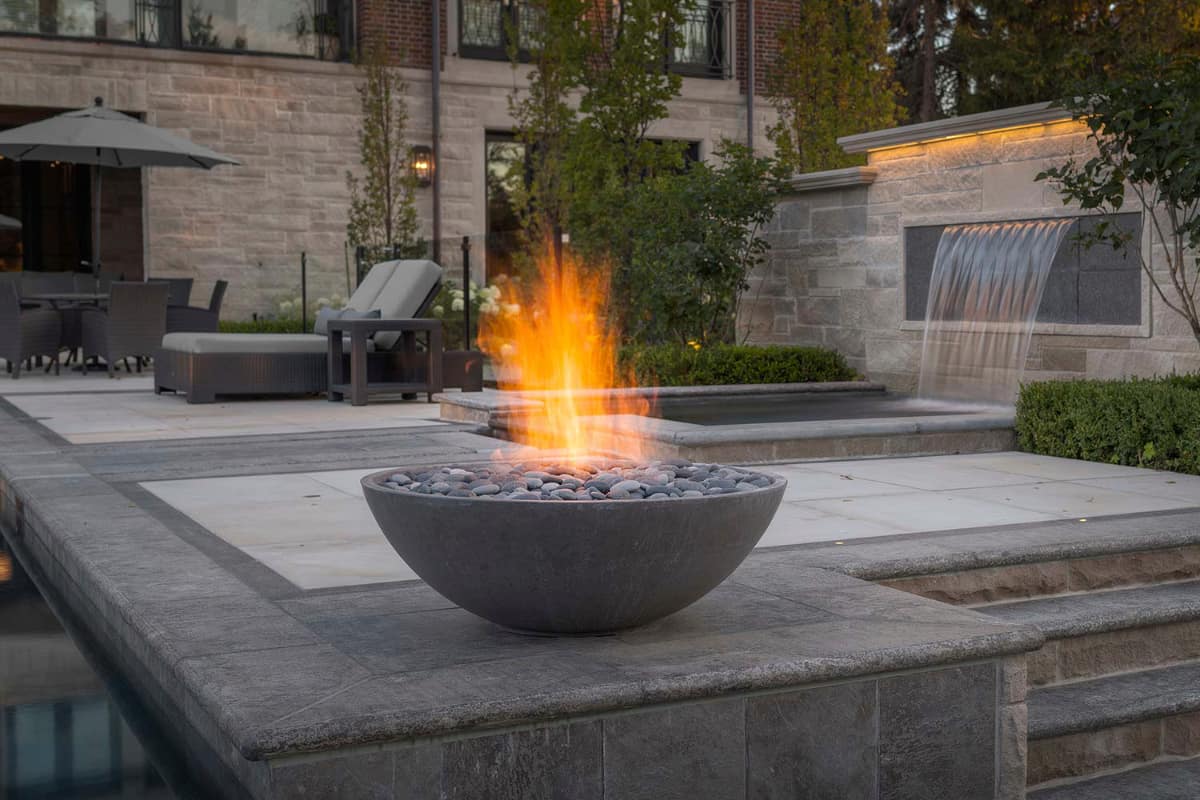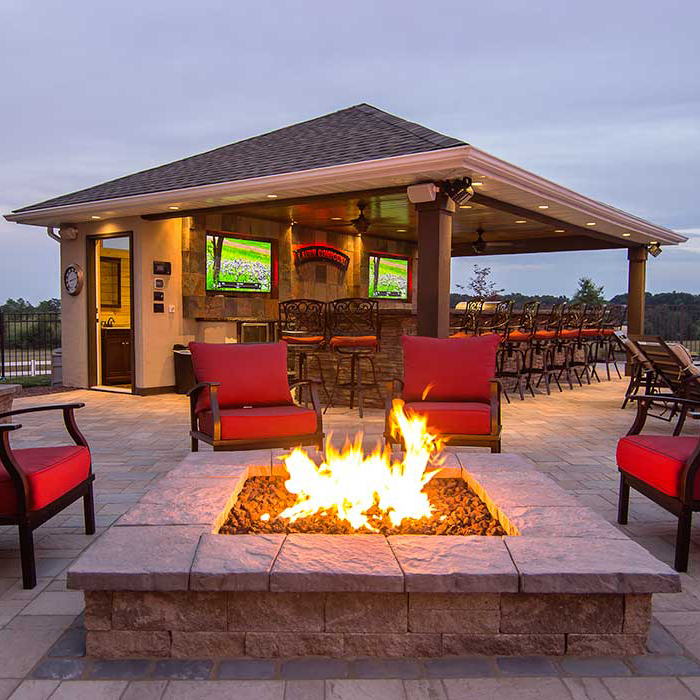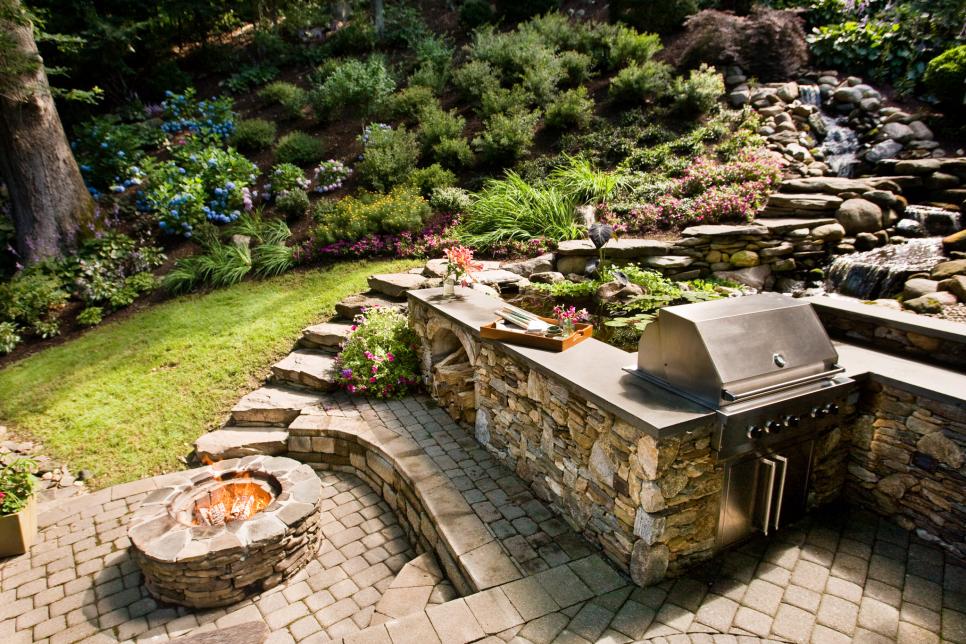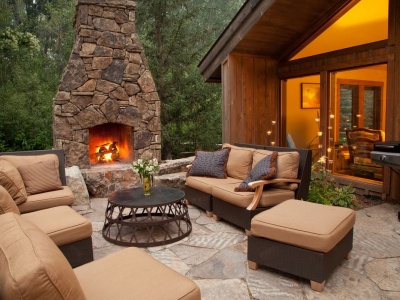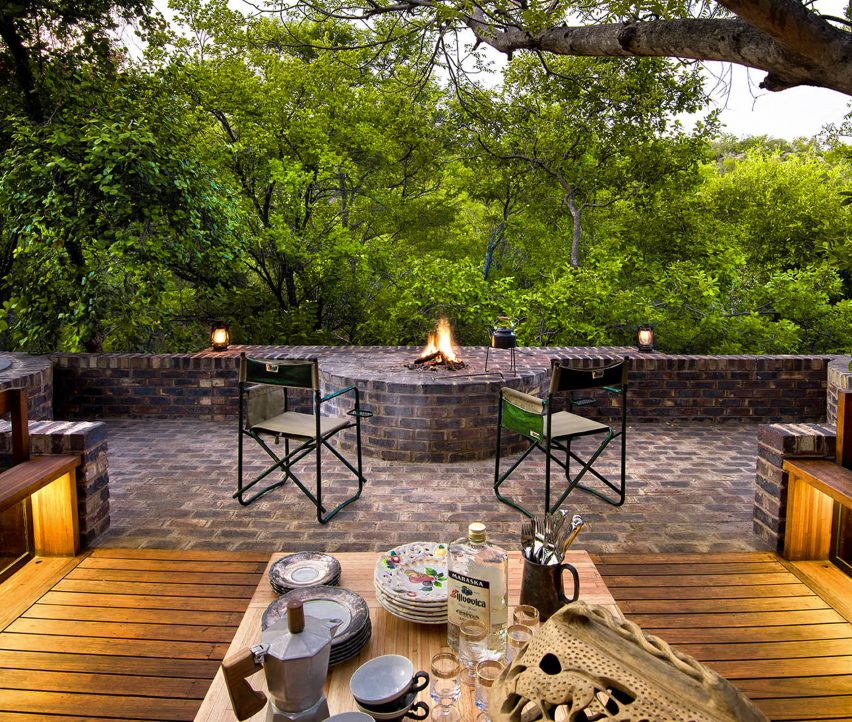When I put an outdoor fire feature in my backyard five years ago, I had no idea how much it would change our outdoor living experience. The dancing flames have become the focal point of numerous family gatherings, the setting for chats with friends, and my own hideaway on cold evenings with a book and a bottle of wine. The roaring fire generates an alluring pull, extending our outdoor season well into the cooler months and providing a natural focal point that complements the overall landscape design. Whether you’re thinking about a permanent stone fireplace or a portable fire pit, I’ll explain how I chose, designed, and enjoyed these outdoor attractions.
Deciding Between Fireplace and Fire Pit
My clients frequently struggle with this essential decision, so I start by asking how they intend to use their outdoor fire element. With their vertical presence and distinct front-facing orientation, fireplaces add a more formal, anchored sense to your outdoor space, creating a living room setting. They offer good directed heat and built-in wind protection, making them appropriate for colder regions or exposed locations. The large building also provides privacy from neighbors and makes a gorgeous architectural element that will become a permanent feature of your landscape design.
In contrast, fire pits provide a more relaxed, communal experience in which people naturally assemble in a circle, resulting in a 360-degree sitting arrangement that facilitates conversation. This circular seating pattern works especially well for larger groups and more informal meetings, in my experience. The open design distributes heat more evenly around the circumference, allowing more people to enjoy the warmth at the same time. Fire pits often require less room and expenditure than fireplaces, making them ideal for smaller yards or tighter budgets.
When assisting customers in making this selection, I analyze their current landscape architecture and outdoor furniture arrangements. Fireplaces look well against walls, at the edge of patios, or as part of outdoor cooking buildings, but fire pits shine as standalone fixtures in more open spaces. Your climate is also important, as fireplaces provide more directional heat and wind protection in colder areas, whilst fire pits provide all-around accessibility and may be more suited to milder climes. Finally, your entertaining style should lead your pick, as each design allows for a unique outdoor gathering experience.
Materials for Longevity and Style
After watching a friend’s gorgeous but poorly constructed brick fireplace disintegrate after only two winters, I realized the necessity of quality materials. Outdoor fire features must endure high temperature variations, wetness, and direct flame exposure, necessitating the use of materials that have been particularly rated for these conditions. Natural stone such as granite, limestone, and bluestone is extremely durable and develops character over time, with each piece weathering uniquely. These materials are normally installed by a professional due to their weight and the competence required to work with them effectively.
Manufactured concrete solutions have transformed outdoor fire feature building, providing incredible endurance while maintaining more uniform colors and patterns than natural materials. I particularly value concrete pavers and blocks developed specifically for fire purposes, as they provide thermal resistance while simplifying construction. For more contemporary designs, I frequently recommend metals such as Corten steel, which develops a stable rustic patina, or stainless steel, which has sleek, modern aesthetics. These metal choices require little upkeep and stand up well to the outdoors.
The inner firebox necessitates extra attention because typical building materials might fracture, spall, or degrade under direct heat. Any wood-burning feature should be lined with fire brick or refractory concrete, but natural gas or propane devices require components certified by the manufacturer and specifically constructed to resist persistent flame exposure. In my opinion, investing in excellent materials upfront saves significant money and frustration when compared to repairing or replacing a failing structure later. I usually advise clients that the visible finishing materials should compliment both the design of their home and the existing landscape components to create a unified outdoor living space.
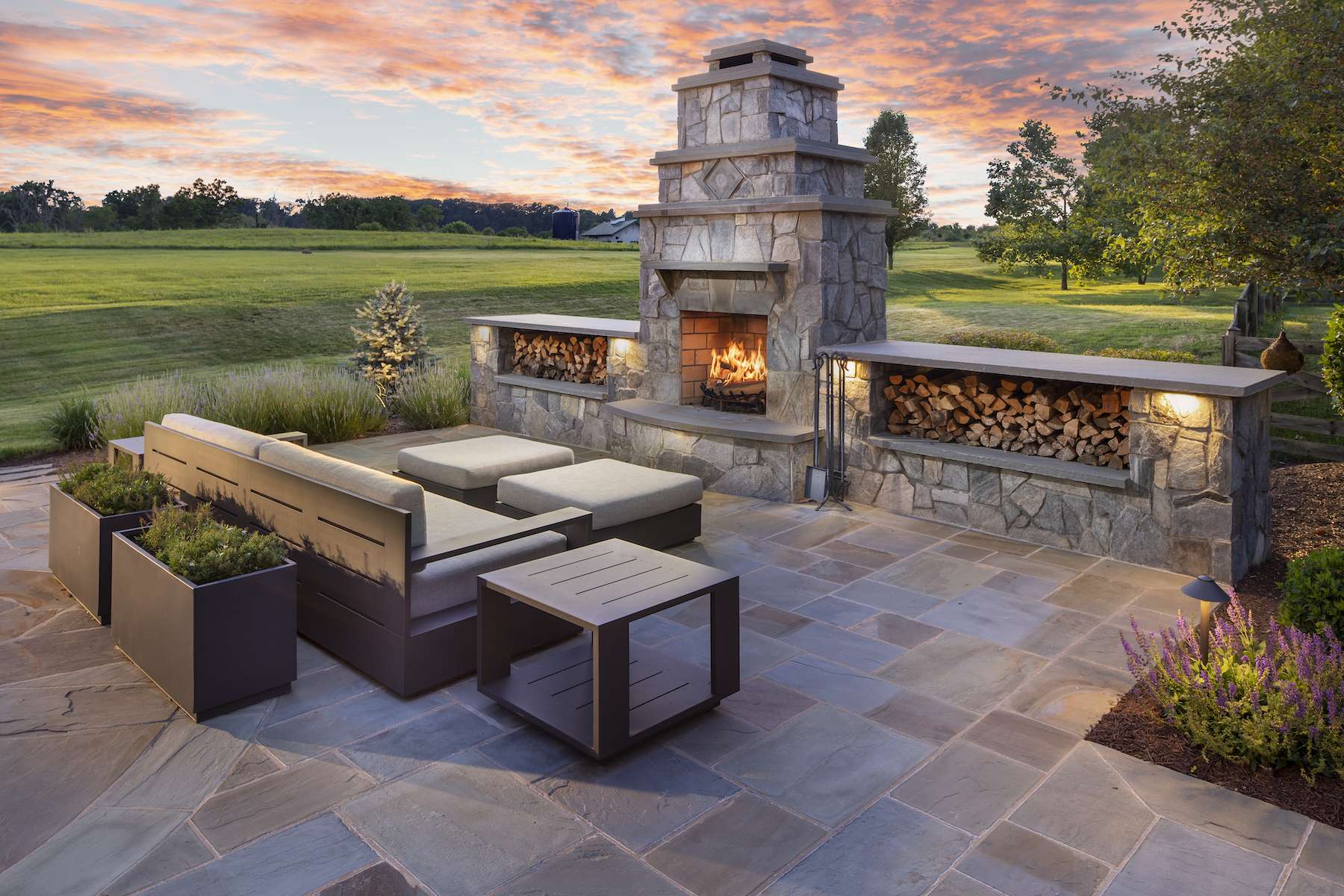
Fuel Options and Practical Implications
After personally experiencing each fuel type, my perspective on them evolved substantially. Traditional wood-burning characteristics provide unparalleled sensory appeal, with a distinct crackling sound, captivating flame patterns, and nostalgic perfume that synthetic alternatives cannot equal. They provide the true campfire experience that many customers particularly want. However, they necessitate constant access to well seasoned logs, emit smoke that can disturb neighbors or people with respiratory sensitivities, and require more cleaning and upkeep than other fuel options.
Natural gas offers outstanding convenience, with fast on/off control, a constant flame, and no ash or cleanup required. After converting my own outdoor fireplace to natural gas, I really value the ability to enjoy a fire for brief periods of time without the commitment that a wood fire requires. The need for skilled gas line installation limits deployment to regions where lines may be easily reached. Propane provides similar simplicity with its portable tank-based operation, making it perfect for areas where natural gas is unavailable, however the tanks must be refilled on a regular basis and placed in an inconspicuous location.
For maximum versatility, I frequently propose dual-fuel designs that can accommodate both wood and gas, allowing options for various occasions and seasons. Several of my clients have adopted bio-ethanol fuels for smaller applications, valuing their clean-burning qualities and renewable nature, even though they typically provide less heat than traditional options. When choosing a fuel type, examine your practical requirements, local regulations, and the amount of effort you’re willing to put into operation and maintenance. Many localities now prohibit wood burning during specific seasons or due to poor air quality, necessitating the use of alternate fuels depending on your region.
Design Considerations for Maximum Enjoyment.
I constantly emphasize intelligent location as the cornerstone of a good outdoor fire feature design. Prevailing wind patterns have a tremendous impact on smoke direction and heat distribution, as I discovered after moving my own fire pit to avoid smoke from flying directly into our principal seating area. Consider proximity to your home for convenience, but keep a safe distance from structures and combustible landscape features. The optimal position strikes a compromise between accessibility and integration into your overall landscape design, resulting in natural traffic patterns that entice people to the fire without interrupting other outdoor activities.
Seating choices significantly influence how people engage with your fire feature. Fixed seating, such as stone walls or built-in benches, establishes permanent meeting places with architectural presence, whilst movable furniture provides flexibility for varying group sizes and seasonal repositioning. I recommend placing seating at varying distances from the fire to meet varied temperature preferences. My outdoor space has both close-in seating for chilly evenings and set-back alternatives for hot nights, offering comfort regardless of weather.
Scale and proportion play a vital role in both visual impact and functional performance. An small fireplace blends into your home’s exterior, whereas a large fireplace dominates the surrounding space. I recommend use the rule of thirds to identify optimal dimensions relative to your whole outdoor space. Height is especially important for fireplaces, as adequate chimney elevation reduces smoke problems while establishing beautiful anchor points in your environment. For fire pits, the best height is often 12-18 inches above ground level, allowing for comfortable seating while safely controlling the flames. Finally, consider including complimentary components such as wood storage, ambient lighting, or privacy screens to improve the whole experience.
Safety and Building Requirements
I cannot underscore the necessity of understanding local restrictions before beginning construction, having seen neighbors endure costly changes after failing to obtain required permissions. Most jurisdictions have precise restrictions for outdoor fire features’ placement, size, and construction methods, which frequently include minimum distances from structures, property lines, and overhead impediments. Many locations distinguish between permanent installations and movable ones, with separate rules governing each group. Fire code compliance is more than just a legal requirement; it addresses legitimate safety concerns based on local conditions and historical fire dangers.
Drainage and foundation systems that are properly engineered help to reduce structural damage and risks. My builder installed a concrete pad that extended at least 12 inches beyond the fireplace footprint, with modest slope to minimize water collecting. In places with freeze-thaw cycles, adequate footings must extend below the frost line to prevent seasonal movement, which can shatter masonry and cause severe instability. The chimney design demands special consideration, with the right height and cap configuration to support an effective draft while avoiding spark emission and wildlife ingress.
Child and pet safety should guide your design decisions from the start. After observing how effortlessly children and dogs move toward fires, I added a raised hearth and ember screen into my own installation. Install a stone or paver safety border at least 3 feet from fire pits to provide a visual boundary for small children. Automatic shut-off valves are critical in gas features because they guard against gas leaks and forgotten flames. While appropriate construction and commonsense procedures eliminate the majority of threats, I recommend keeping a garden hose or fire extinguisher nearby as an added safety step, especially for wood-burning features that can cause unexpected flare-ups.
Maintenance and Seasonal Care
My maintenance approach developed through trial and error after I discovered that ignored fire features deteriorate quickly when exposed to the weather. Wood-burning stoves require regular ash removal to ensure adequate airflow and prevent moisture damage to the firebox bottom. I clean mine after every few uses and place the cooled ashes in my flower beds, where they give precious minerals. Periodic inspection of masonry joints prevents water infiltration, which causes cracking during freeze-thaw cycles. I reapply masonry sealant every few years to keep porous materials from staining and weathering.
Gas fire features require particular maintenance, most notably maintaining burners and gas ports free of material that can impede flame patterns or create hazardous circumstances. I plan professional inspections of gas lines, connections, and valves once a year to assure their continuous safe operation. Spider webs, an incredibly common problem, can clog gas orifices and pilot lights, necessitating seasonal cleaning with compressed air. For both fuel types, chimney cleaning eliminates dangerous creosote accumulation in wood-burning devices and removes nesting materials from gas fireplaces, which birds frequently introduce during inactive times.
Proper seasonal protection substantially extends the life of your feature. In my northern climate, covering the fireplace or pit during the winter months keeps water out and prevents frost damage to the building. Metal components are protected from precipitation by custom-fitted coverings, which also allow air circulation to minimize moisture and mold formation. Before winter, I drain any water lines supplying outdoor kitchens or sinks near the fire feature to avoid freezing and pipe bursts. In coastal areas, however, salt air corrosion poses a hazard to metal components, necessitating more frequent cleaning and preventative treatment to maintain both function and attractiveness. These maintenance techniques may appear demanding at first, but they eventually become simple habits that protect your investment.
What is the normal cost of building an outdoor fireplace or firepit?
According to my experience and conversations with various contractors, prefabricated fire pits normally cost $300-1,500 for excellent units, while bespoke built-in versions cost $1,500-5,000 depending on size, materials, and complexity. Outdoor fireplaces are far greater investments, with prefabricated units starting around $2,000-4,000 and custom masonry versions ranging from $8,000-20,000+ for intricate designs with quality materials. These prices vary greatly by area, with labor expenses accounting for a significant amount of unique installations.
How close may I position my fire feature to my house or wooden structures?
Safety clearances vary depending on the feature type and local building standards, but I normally recommend a minimum distance of 10-15 feet from any structure for wood-burning features. Gas units often allow for closer placement, often within 5-10 feet of combustible items, but specific manufacturer guidelines and local codes always take precedence. Always verify with your local fire department or building authority for specific standards, as they vary greatly between jurisdictions.
Do I need a permit to create an outdoor fire feature?
Most permanent installations require permissions, although many portable devices do not. In my location, every structure with a foundation, a gas line hookup, or a size that exceeds specified limits requires approval. The permitting process normally entails submitting design plans, specifying materials, and, in some cases, scheduling inspections during construction. Check with your local building department early in the design process to avoid costly changes or removal orders if your installation does not satisfy code requirements.
What type of upkeep is necessary for outdoor fireplaces and fire pits?
Regular maintenance includes cleaning ashes from wood-burning devices after 3-4 uses, assessing stonework for cracks each spring, clearing debris from gas burners monthly during the season, and having gas lines professionally inspected once a year. I propose covering your feature during long periods of inactivity and adding proper sealants to brickwork every 2-3 years. Wood-burning chimneys should be inspected on an annual basis for creosote accumulation and blockages that could cause fires.
What is the most cost-effective gasoline type for regular use?
According to my estimates tracking our usage, wood is still the most cost-effective fuel if you have access to low or free seasoned firewood, which costs about $1-3 per hour of operation. Natural gas follows at around $2-4 per hour, depending on local rates and feature size. Propane is the most expensive, costing $3-6 per hour, with the extra annoyance of tank exchanges. However, installation expenses significantly alter this equation, as wood requires little infrastructure, whereas gas installations demand considerable upfront costs for lines, connections, and safety measures.
How can I use a fire feature to lengthen the outdoor living season?
Strategic placement generates protected microclimates, which considerably increases outdoor enjoyment. I place seating where the fire’s radiating heat interacts with windbreaks from neighboring structures or landscape elements. Using portable patio heaters as auxiliary heat sources increases the range of tolerable temperatures. Weather-resistant couches and throw blankets encourage staying outside, while strategically placed lighting extended evening use. Consider retractable coverings or pergolas that offer weather protection while also allowing for smoke dispersal from wood fires.
Firepits + Outdoor Fireplaces – Above & Beyond
Outdoor Fire Pits and Fireplaces in El Paso Dorian Construction
Ten outdoor spaces with warming fireplaces and fire pits
Related Posts:
- Stacked Stone Outdoor Fireplace
- DIY Small Outdoor Fireplace
- Outdoor Fireplaces Firepits
- Simple Brick Outdoor Fireplace
- Ideas For Outdoor Fireplaces On Patios
- Outdoor Fireplace Ideas Stone
- Outdoor Rock Fireplace Designs
- DIY Outdoor Fireplace Designs
- Outdoor Fireplace Ideas Deck
- Outdoor Cooking Fireplace Designs



